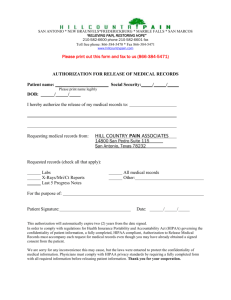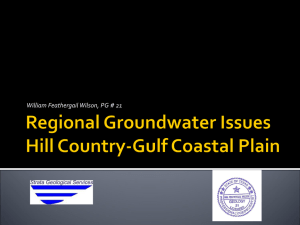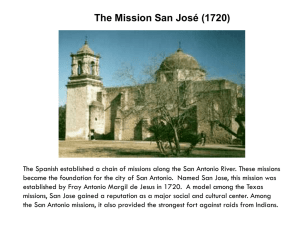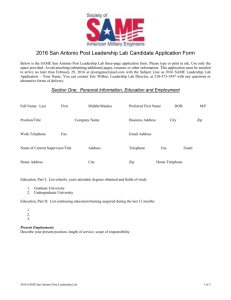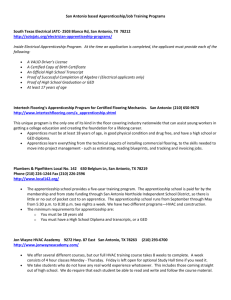Report on Regional Water Planning for South Central Texas
advertisement
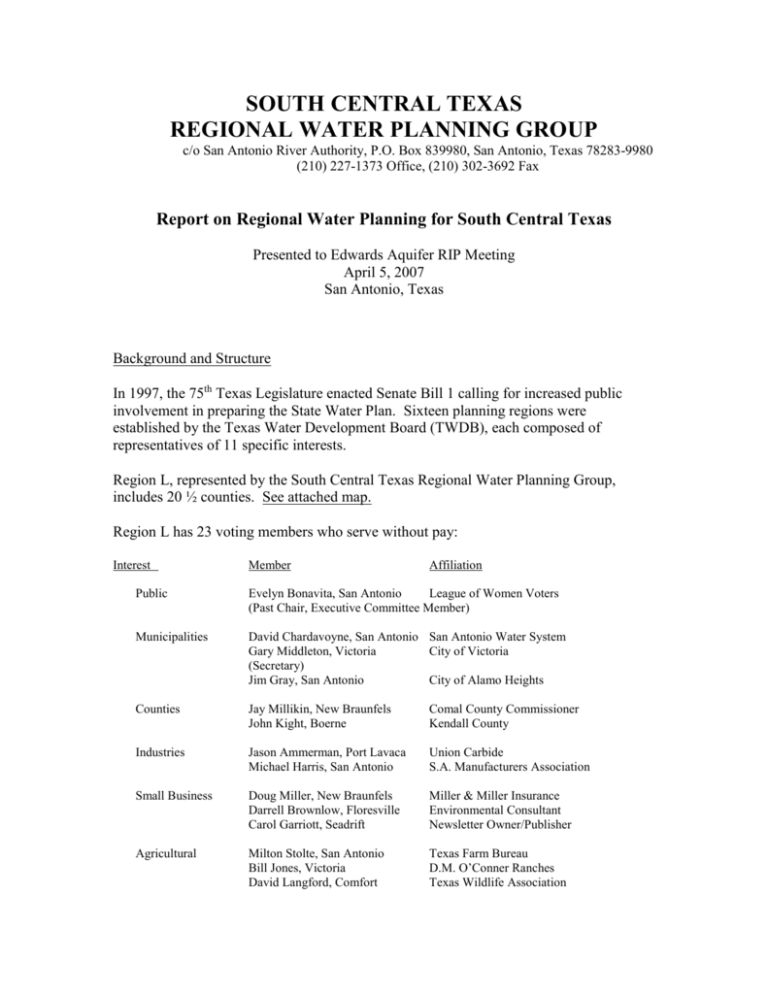
SOUTH CENTRAL TEXAS REGIONAL WATER PLANNING GROUP c/o San Antonio River Authority, P.O. Box 839980, San Antonio, Texas 78283-9980 (210) 227-1373 Office, (210) 302-3692 Fax Report on Regional Water Planning for South Central Texas Presented to Edwards Aquifer RIP Meeting April 5, 2007 San Antonio, Texas Background and Structure In 1997, the 75th Texas Legislature enacted Senate Bill 1 calling for increased public involvement in preparing the State Water Plan. Sixteen planning regions were established by the Texas Water Development Board (TWDB), each composed of representatives of 11 specific interests. Region L, represented by the South Central Texas Regional Water Planning Group, includes 20 ½ counties. See attached map. Region L has 23 voting members who serve without pay: Interest Member Affiliation Public Evelyn Bonavita, San Antonio League of Women Voters (Past Chair, Executive Committee Member) Municipalities David Chardavoyne, San Antonio San Antonio Water System Gary Middleton, Victoria City of Victoria (Secretary) Jim Gray, San Antonio City of Alamo Heights Counties Jay Millikin, New Braunfels John Kight, Boerne Comal County Commissioner Kendall County Industries Jason Ammerman, Port Lavaca Michael Harris, San Antonio Union Carbide S.A. Manufacturers Association Small Business Doug Miller, New Braunfels Darrell Brownlow, Floresville Carol Garriott, Seadrift Miller & Miller Insurance Environmental Consultant Newsletter Owner/Publisher Agricultural Milton Stolte, San Antonio Bill Jones, Victoria David Langford, Comfort Texas Farm Bureau D.M. O’Conner Ranches Texas Wildlife Association 2 River Authorities Con Mims, Uvalde (Chair) Bill West, Seguin Greg Rothe, San Antonio Nueces River Authority Mike Mahoney, Pleasanton (Vice-Chair) Robert Potts, San Antonio Evergreen Underground Water Cons. Dist. Water Utilities Ron Naumann, Seguin (Executive Committee Member) Springs Hill Water Supply Corporation Elec. Gen. Util. Mike Fields, Fannin Coleto Creek Power Environmental Iliana Pena, San Antonio Donna Balin, San Antonio Mitchell Lake Audubon Center Geologist Water Districts Guadalupe-Blanco River Authority San Antonio River Authority Edwards Aquifer Authority The San Antonio River Authority serves as our administrative agency, since regional water planning groups have no authority to contract. To accomplish our work, we employ technical and public facilitation consultants and use the expertise and guidance of TWDB. The regional plans are updated in five year cycles. Each plan must identify water demands in the region over a fifty year planning horizon for each of six categories of use–municipal, industrial, steam-electric power generation, mining, irrigation, and livestock. Then, supplies are identified to meet those demands through the drought of record. Project costs are calculated and environmental impacts are evaluated. The 2006 Regional Plan Our latest water plan was completed in January 2006 and is included in the 2007 State Water Plan prepared by TWDB. We are, now, starting the next five year planning cycle for what will result in an updated regional plan in 2011. The following is a brief overview of our 2006 Water Plan, according to my understanding of the Plan. Definitive information is available by referring to the Plan on the TWDB website (http://www.twdb.state.tx.us): - Population is expected to double, reaching about 4.3 million people by 2060. - Municipal water use in the region will nearly double, growing from about 340,000 acre-feet annually to about 637,000 acre-feet, annually. This assumes aggressive implementation of water conservation measures throughout the region. The plan counts on water conservation to meet about 16% of future needs. - The Plan contains about 26 water management strategies recommended to meet future needs. 3 - There are 111 cities or other water supply entities in the region for which population and water demands are projected in the Plan and for which supplies are identified to meet the demands. - The need for new supplies in the region for all uses except irrigation and livestock is expected to grow from about 101,000 acre-feet in 2010 to about 381,000 (416,850 including irrigation and livestock) acre-feet in 2060. So, in approximately the next three years, this region will need to increase its current water supplies by about 30% and in the next 50 years current supplies will need to more than double to meet what, essentially, amounts to growth in municipal and industrial needs. - The 2006 Plan provides for new supplies in excess of 738,000 acre-feet per year by 2060, considerably more than the 381,000 acre-feet needed (without considering irrigation and livestock needs). - The largest water demand in the region is from the City of San Antonio. (Figures shown, below, are total water demand, as opposed to new supplies needed.) The largest sub-regional demand center in the region is the area from San Antonio along I.H. 35 to San Marcos. Region Municipal Demand 2010 395,994 2060 637,235 City of San Antonio 2010 216,945 54% of region demand 2060 317,727 49% of region demand The 2006 plan provides for excess supplies because of future uncertainties in, for example: - the ability to obtain all necessary permits for the projects, encountering a drought worse than the drought of record, not knowing what supply will be available from the Edwards Aquifer in the future(*), and not knowing what “Desired Future Conditions” will be established for the aquifers(**) (*) The Edwards Aquifer Authority (EAA) statute, Senate Bill 1477, requires EAA to limit Edwards Aquifer pumpage to 450,000 acre-feet, annually, until the end of 2007 and then to reduce it to 400,000 acre-feet, annually, beginning in 2008. But, the EAA statute also requires the agency to ensure continuous minimum springflows at Comal and San Marcos springs to protect endangered species by the end of 2012. According to independent studies, to maintain uninterrupted discharge of at least 60 cfs from Comal Springs during a repeat of the drought of record, pumping from the Edwards Aquifer would have to be reduced to about 225,000 acre-feet. So, pumping limits for the aquifer may have to be less than the 400,000 acre-feet provided for in SB1477 to protect these spring flows. 4 After considerable discussion by the planning group, a pumping level of 340,000 acrefeet, annually, was agreed upon as a placeholder amount for planning purposes until the Edwards Aquifer Authority receives U.S. Fish and Wildlife Service approval of a Habitat Conservation Plan that will better establish what is needed to protect the endangered species at the springs. Now, of course, there is the possibility that this Edwards Aquifer RIP process may be given a chance to establish those needs through a collaborative effort of the stakeholders. If, ultimately, pumping from the Edwards Aquifer is limited by law to less than 340,000 acre-feet provided for in our regional plan, then other projects will be needed to make up the reduced supply. (**) By September 1, 2010, groundwater conservation districts operating within stateestablished groundwater management areas must agree upon desired future conditions for the aquifers in their management area. It is nearly assured that when the future desired aquifer conditions are established, the quantities of groundwater shown in the 2006 Region L Plan as being available for use will change and, I expect, will, be reduced. Strategies in the 2006 Plan involving the Edwards Aquifer There are three water management strategies in the Plan involving the Edwards Aquifer that should be noted: The first recommended strategy is converting existing irrigation permits to municipal and industrial use. The EAA statute allows irrigation permit holders to sell or lease up to 50% of their rights. In our planning process an analysis was made of the amount of irrigation water that is potentially available for sale or lease for municipal and industrial uses. The Plan anticipates about 64,000 acre-feet of converted rights to be available for municipal and industrial use in 2010, increasing to about 71,000 acre-feet in 2060. This water is earmarked in the Plan to help meet the needs of 23 municipal water users. The second recommended strategy involving the Edwards Aquifer is the proposed construction of recharge dams. Three scenarios were studied involving different numbers of recharge structures. The scenario that appears to be the most efficient in terms of both enhanced recharge and cost is one involving construction of dams directly over the aquifer recharge zone on the Frio and Sabinal rivers and the Hondo and Verde creeks in the Nueces Basin and one on the Cibolo Creek in Bexar County. With these structures, and the modification of outlets on two existing flood control dams on Salado Creek in Bexar County, recharge is expected to be enhanced by about 54,000 acre-feet, annually, on the average and about 10,000 acre-feet, annually, during drought conditions. The increase in sustained yield of the aquifer with these projects is estimated to be about 13,000 acre-feet, annually. This is the amount that, depending on EAA rules yet to be developed, could be considered for additional use under a recharge recovery permit. A third strategy involving the Edwards Aquifer is a conceptual recharge and recirculation system. This strategy involves artificial recharge of the aquifer from yet to be identified sources and capture of the resulting increased springflows for recirculation in the form of additional recharge. The concept is to maintain springflows at levels to protect the 5 endangered species at Comal and San Marcos springs while allowing increased pumping from the aquifer to meet municipal and industrial water needs. This project is being studied by the EAA and is recognized in the Region L plan as having potential but requiring further evaluation. Social Concerns in Regional Water Planning There are social problems faced in developing regional water plans that the average person never thinks about, but should. We must understand that in nearly every situation where new water supplies are needed to meet expanding municipal and industrial needs, that water is found in the rural areas in the form of river flows and groundwater aquifers. For generations, they have provided environmental and economic benefits to the rural communities and those visiting. Generally, people in the rural areas see large municipal water suppliers as intimidating and untrustworthy. They see the big cities coming after the rural water and threatening their economic future. They fear reduced or eliminated spring flows, lowered river flows, lowered groundwater levels, increased cost of pumping private wells, reduced environmental flows, and reduced capacity for future growth. The big cities have deep pockets and political influence. The rural communities don’t. The municipal water suppliers, on the other hand, are generally responsible for the health, safety and wellbeing of thousands of people and enormous economies and they can not fail in their duties to continually provide adequate supplies of affordable, good quality, water. Projects they pursue, usually, have been thoroughly studied at great public expense and have been authorized by their governing bodies. Since the Region L plan is very dependent on groundwater for new supplies, the burden of helping to satisfy regional needs while protecting local environments and economies will rest heavily on the backs of the groundwater districts of this region. For fairness to all sides, it will be critical for the groundwater districts to have well thought out, scientifically based, management plans and rules, adequate funds, and intelligent, openminded leadership. Future Planning Activities We, currently, are awaiting TWDB funding of the first two years of the next five year planning cycle. We are expecting about $447,000 in TWDB funds, to which will be added about $79,000 of local funds to accomplish six activities over the next two years: - Administrative and Public Participation Activities - Lower Guadalupe Water Supply Project (LGWSP) for GBRA Needs 6 This project is designed to move about 63,000 acre-feet of surface water supplies, annually, from the lower Guadalupe Basin to the San Marcos and Boerne region. Work will involve updating the technical evaluation of the project, refining the design and operation of the project to minimize adverse impacts on the environment and local economic conditions, and updating the costs. - Brackish Groundwater Supply Evaluation This work will identify areas for development of brackish groundwater supplies from the Edwards and Gulf Coast Aquifers for representative water user groups potentially including SAWS, Woodsboro, and Seadrift and will review and refine technical information regarding one brackish groundwater supply project from the Wilcox Aquifer being evaluated by SAWS under separate contract. SAWS is contributing nearly $26,000 toward this study. - Enhanced Water Conservation, Drought Management, and Land Stewardship Here, we will review and refine conservation recommendations found in the 2006 Regional Water Plan and estimate costs and benefits with emphasis on condensate collection, rainwater harvesting, drought management and land stewardship. - Environmental Studies Among other things, we will research and refine estimates of historical diversions and effluent discharges affecting flows in the lower Guadalupe River and freshwater inflows to the Guadalupe Estuary prior to 1977 and we will evaluate potential effects on fisheries harvest equations for selected species of interest. Additionally, we will receive ecosystem modeling services from Texas A&M University in the continued development of a simulation model linking freshwater inflows to marsh ecosystem dynamics in San Antonio Bay. Since 2002, San Antonio Water System, San Antonio River Authority, and Guadalupe-Blanco River Authority have sponsored a study by Texas A&M University linking freshwater inflows and marsh community dynamics in San Antonio Bay to whooping cranes. Both the San Antonio River Authority and the Guadalupe-Blanco River Authority will be contributing to the funding of this work element. - Environmental Evaluations of Water Management Strategies While Region L has been singled out for praise by state officials for providing in-depth evaluations of the potential environmental impacts associated with the various water management strategies in its regional plan, the planning group is interested in doing more to ensure that environmental concerns are fully evaluated for each water management strategy. So, under this task, we will conduct workshops in which we will compare environmental evaluations in our 2006 Plan to those performed by other planning regions and solicit comments regarding potential improvements that we could incorporate into our evaluations for our 2011 Plan. 7 Conclusion As we begin updating our 2006 regional plan, we invite you to attend our meetings. We meet, quarterly, usually at the San Antonio River Authority offices at 100 E. Guenther Street, across from Pioneer Flour Mills. If you wish to be notified of our meetings, or need other information concerning Region L, please contact Bob Perez at the San Antonio River Authority at (210) 302-3279 or email rperez@sara-tx.org. Respectfully submitted, Con Mims, Chair South Central Texas Regional Water Planning Group (Region L)


